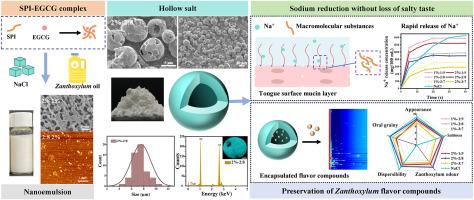空心盐-纳米乳液复合材料:一种同时还原钠和保留风味的花椒风味构建新载体
IF 11
1区 农林科学
Q1 CHEMISTRY, APPLIED
引用次数: 0
摘要
设计中空盐制品已成为一种新兴的减钠手段,可以在不失去咸味的情况下实现减钠。与现有的中空盐工艺相比较,本研究旨在构建一种能保存花椒风味的中空盐载体。此外,利用SPI-(−)-表没食子儿茶素-3-没食子酸酯(EGCG)配合物与花椒油形成的纳米乳,通过喷雾干燥法制备花椒风味中空盐。采用含有2% (w/v) SPI-EGCG配合物、油水比为2:8的纳米乳制备的空心盐粒径分布均匀,平均微球直径为7.57±1.60 μm。其钠含量为223 mg/g,得率为41%,花椒油包埋率为60%。感官评价结果表明,当空心盐和传统氯化钠(NaCl)在相同质量下进行比较时,在感知咸味方面没有显着差异(P > 0.05)。通过分析钠的体外释放和测量钠在猪舌表面的保留,钠可以从中空盐中快速释放,在舌表面的保留时间延长,即使在低钠浓度下也能提供增强的咸味。此外,顶空气相色谱-离子迁移率光谱分析表明,喷雾干燥的空心盐的风味保留率高度依赖于油水比配方。值得注意的是,2% SPI-EGCG-2:8油水空心盐配方对花椒香精挥发性有机物的保存效果最好。本研究证明了开发新型低钠中空盐产品的可行性,并增强了盐味感知。本文章由计算机程序翻译,如有差异,请以英文原文为准。

Hollow salt-nanoemulsion composites: A novel carrier for Zanthoxylum flavor construction with simultaneous sodium reduction and flavor retention
Designing hollow salt products has become an emerging means of reducing sodium, which can achieve sodium reduction without losing its salty taste. Compared with existing hollow salt technology, this study aims to construct a hollow salt carrier that can preserve the Zanthoxylum flavor. Furthermore, the nanoemulsion formed by SPI-(−)-epigallocatechin-3-gallate (EGCG) complex and Zanthoxylum oil was used to produce hollow salt with Zanthoxylum flavor through spray drying. The hollow salt prepared by the nanoemulsion containing 2 % (w/v) SPI-EGCG complex and an oil-water ratio of 2:8 exhibited a uniform particle size distribution, with an average microsphere diameter of 7.57 ± 1.60 μm. It has a sodium content of 223 mg/g, a yield of 41 %, and a Zanthoxylum oil embedding rate of 60 %. The findings from the sensory evaluation showed that when hollow salt and traditional sodium chloride (NaCl) were compared at an equal mass, there was no substantial disparity in terms of the perceived saltiness (P > 0.05). By analyzing the in vitro release of sodium and measuring sodium retention on a pig's tongue surface, sodium can be rapidly released from hollow salts with the extended retention on the tongue surface, providing an enhanced salty sensation even at low sodium concentrations. Furthermore, headspace gas chromatography-ion mobility spectrometry analysis revealed that the flavor retention rate in hollow salt is highly dependent on the oil-water ratio formulations by spray drying. Notably, the 2 % SPI-EGCG-2:8 oil-water hollow salt formulation has the best performing for preserving the volatile organic compounds of Zanthoxylum flavor. This study demonstrates the feasibility of developing novel low-sodium hollow salt product with the enhanced salt-taste perception.
求助全文
通过发布文献求助,成功后即可免费获取论文全文。
去求助
来源期刊

Food Hydrocolloids
工程技术-食品科技
CiteScore
19.90
自引率
14.00%
发文量
871
审稿时长
37 days
期刊介绍:
Food Hydrocolloids publishes original and innovative research focused on the characterization, functional properties, and applications of hydrocolloid materials used in food products. These hydrocolloids, defined as polysaccharides and proteins of commercial importance, are added to control aspects such as texture, stability, rheology, and sensory properties. The research's primary emphasis should be on the hydrocolloids themselves, with thorough descriptions of their source, nature, and physicochemical characteristics. Manuscripts are expected to clearly outline specific aims and objectives, include a fundamental discussion of research findings at the molecular level, and address the significance of the results. Studies on hydrocolloids in complex formulations should concentrate on their overall properties and mechanisms of action, while simple formulation development studies may not be considered for publication.
The main areas of interest are:
-Chemical and physicochemical characterisation
Thermal properties including glass transitions and conformational changes-
Rheological properties including viscosity, viscoelastic properties and gelation behaviour-
The influence on organoleptic properties-
Interfacial properties including stabilisation of dispersions, emulsions and foams-
Film forming properties with application to edible films and active packaging-
Encapsulation and controlled release of active compounds-
The influence on health including their role as dietary fibre-
Manipulation of hydrocolloid structure and functionality through chemical, biochemical and physical processes-
New hydrocolloids and hydrocolloid sources of commercial potential.
The Journal also publishes Review articles that provide an overview of the latest developments in topics of specific interest to researchers in this field of activity.
 求助内容:
求助内容: 应助结果提醒方式:
应助结果提醒方式:


